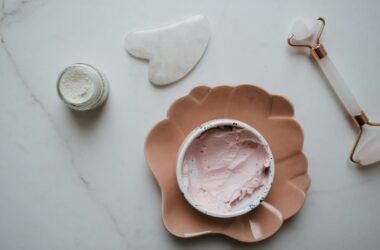Can you use mandelic acid with azelaic acid? Both of these acids are used in skin care products and are great ingredients for treating blemishes, sun damage and acne scars.
They reduce redness and help to fade pigmentation, but what do they do differently and can they be used at the same time?
Can You Use Mandelic Acid With Azelaic Acid?
Azelaic acid is a type of acid that can be used to treat acne, rosacea and hyperpigmentation. It’s widely available in over-the-counter products but also prescribed by dermatologists for stronger formulations.
Mandelic acid, on the other hand, is less well known and has fewer uses. However, it’s great for treating wrinkles and hyperpigmentation. It is also commonly used as a chemical peel in dermatology offices.
Can mandelic and azelaic acids be used together?
The answer is yes! Azelaic acid can in fact help with some of the downsides of mandelic acid — namely, its slow absorption rate.
While azelaic acid isn’t a penetration enhancer, it does have anti-inflammatory properties that can help keep skin calm while you’re using a strong concentration of mandelic acid.
Azelaic acid can also help with the redness that often accompanies mandelic acid application.
In short, azelaic acid can be used alongside mandelic acid to enhance its effectiveness while reducing any side effects you may experience from using it by itself.
How To Incorporate Mandelic Acid With Azelaic Acid Into Your Routine
Here are 10 tips on how to incorporate Mandelic Acid with Azelaic Acid into your routine:
1. Use mandelic acid in the AM, always with sunscreen
2. Use azelaic acid in the PM, after cleansing, and before moisturizer
3. Don’t apply alpha hydroxy acids on top of one another; wait for one to dry and then apply the other
4. Combine mandelic and azelaic acids into single serums/toners/lotions for a gentle daily exfoliant.
5. Alternate using mandelic and azelaic acids every day until your skin is used to them, then switch to using them together twice per day
6. If you have sensitive skin, patch test before incorporating either acid into your routine
7. Don’t use these acids if you’re pregnant or breastfeeding
8. If you’re already on retinoids or Accutane, consult an expert before adding mandelic acid to your routine
9. If you have sensitive skin, start by applying every other night until your skin gets used to it; then move up to nightly application when your skin can handle it
10. Don’t use these acids if you have active acne or rosacea.
How To Use Azelaic Acid And Mandelic Acid Together Safely
Here’s how to use the two acids together safely:
Step 1
Wash your face with a gentle cleanser, then dry it with a clean towel.
Step 2
Apply a pea-sized amount of azelaic acid cream to affected areas of the face (and neck if desired).
Step 3
Apply a pea-sized amount of mandelic acid serum to affected areas of the face (and neck if desired).
Step 4
Wait at least 20 minutes before applying moisturizer and SPF during the day, or any other products you wish to apply afterward.
Step 5
Follow this routine every morning until the skin has acclimated to daily use of both acids, then switch to alternating between every other day and every day as needed for maintenance
Step 6
If irritation occurs, reduce the frequency of use and/or alternate days until skin adjusts.
What Percentage Of Mandelic Acid Should You Use While Using Azelaic Acid?
You can start with a 10% mandelic acid serum and use it 3-4 times a week.
The frequency of usage of the serum depends on how your skin reacts to it. If you are using too much mandelic acid, you might notice some tingly sensations or temporary redness.
This is normal and your skin will adjust to it after a few uses.
If you are using both the acids together, I would recommend using the azelaic acid at night and the mandelic acid in the morning.
Both these acids have different pH levels and that’s why you should use them at different times.
Is Mandelic Acid Better Than Azelaic Acid?
Mandelic acid is not better than azelaic acid — they’re just different.
Mandelic acid has bigger molecules, so it’s more gentle and is used for less severe cases of acne. But it doesn’t work quite as fast as azelaic acid.
So if someone has a rash or extreme redness, I’ll recommend azelaic acid. For people who have mild to moderate acne, I recommend mandelic acid.
Benefits Of Using Mandelic Acid And Azelaic Acid Together
Mandelic acid and azelaic acid are both alpha-hydroxy acids (AHAs) that exfoliate the uppermost layer of the skin. They also have antibacterial and antioxidant properties. Using these two acids in combination has many benefits, like:
1. Reducing hyperpigmentation
Both mandelic acid and azelaic acid have been shown to have anti-inflammatory benefits that are beneficial for those with rosacea or sensitive skin types because they help to reduce redness associated with inflamed areas of the skin on the face.
2. Improving skin texture
Azelaic acid can provide anti-aging benefits by improving the overall texture and appearance of the skin while smoothing out fine lines and wrinkles on the face.
3. Brightening the complexion
These acids also help to brighten the skin’s appearance while exfoliating away dead skin cells.
4. Preventing breakouts
Mandelic acid is an AHA, alpha hydroxy acid, which helps to exfoliate and promote cell turnover to reveal healthy new skin cells; while azelaic acid is a BHA, beta hydroxy acid, which helps to unclog pores and reduce acne breakouts.
5. Reducing redness
They are also effective in fighting acne breakouts and reducing the appearance of acne scars and dark spots.
Final Thoughts
These are two examples of alpha-hydroxy acids, which are a group of chemicals that work in a similar way.
Because they are related, they can both be used to exfoliate the skin.







